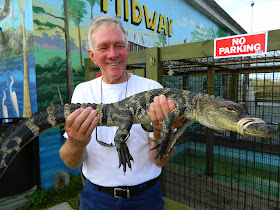Readers who may be unfamiliar with full-time RV life may look at this blog and think that all we do is go from one glorious location to the next grand adventure. It's true, we do that, but interspersed is a surprising amount of mundane chores, maintenance, and repairs necessary to keep our home on the road. Most of the chores are universal, like laundry, grocery shopping, paying bills, cooking, cleaning house, washing the car and walking the dog. Some are more unique to RV life, like route planning, emptying the black and grey tanks, refilling propane tanks and climbing on top of the rig to wash the roof and the solar panels.

We've also had our share of minor repairs and other bothers that have required some sweat and ingenuity, mostly from Rick. I just chip in with an occasional bright idea. (Here's a little fix I made on the drill-like tool we use to lower the spare tire. I added the tennis ball to make it easier to hold and add pressure as needed without slippage. Brilliant, if I do say so myself.)
Since we've been here at The Great Outdoors, in Titusville, FL, we've been attending to some long needed repairs and other kinds of critical problems that just recently came to our attention.
First, we had a small insulated window that fogged up about eight months ago, that we've been trying to replace since then. It was covered by our original warranty, so DRV (that's the company that made our Mobile Suite fifth wheel trailer) sent us a replacement window, but not quickly. We missed opportunities to replace it earlier, and finally got it taken care of at
Eagles Pride RV Repair right here at The Great Outdoors. A very nice repairman came right to our site and popped out the old window (shattered glass all over the place - oops) and popped in the new one with just a little problem. It seems that the rivets that hold the window in are not accessible without removing or cutting out the wood trim from the inside of the window (who engineered that?) - a big deal that he didn't have the right tools for. So he said he'd come back first thing on Monday with the right tools. Monday came, the morning passing, and no repairman. But in the meantime Rick put his mind to it and came up with the perfect solution. Cable ties! It would be a little too complicated to explain just how, but here are a few pictures. The two skinny black lines are the cable ties threaded through the rivet holes, with the excess ends still on.
Here the excess is cut off, leaving just the snug little loops holding the window in place.
And here's how it looks with the screen back in. Perfect!
This is not the first time he's used cable ties to solve repair problems. They are an indispensable tool to have around, and I highly recommend them to anyone who is traveling without them. Better than duct tape in many situations. We like electrical tape too.
Now, the "Wheels and Tires Rodeo," as Rick dubbed it. We've had trouble with our tires' valve stems since the beginning, resulting in a few surprise flats while parked at campgrounds (thank goodness), and occasional low pressure. Several months ago Rick talked with
Tredit Tire, the supplier of the tires to DRV, and they sent us new heavy duty brass valves to replace all five of our old leaky ones, at no cost to us. So this week Rick changed out
every tire, taking them off one by one, wrangling them into the back of the Subaru and driving them to a tire shop in Cocoa Beach to replace the valves. Now let me just say, these are not your everyday tires - they are massive compared to those you know from your car. Now this is all taken care of and we hope we'll have no more trouble with air loss. Thank you cowboy Rick.
AND, while emptying our tanks at our last location I noticed that one of our tires was dramatically worn on the two inside treads. This sent us into problem solving mode again.
This kind of uneven tire wear is usually an indication of an alignment problem. After much research and many phone calls to DRV, Lippert (who makes the axles), our extended warranty company and several repair shops, Rick made an appointment at
Josam in Orlando, who seem to be THE pros for this kind of work. Field trip!
Josam assessed our axles and discovered that ALL our wheels and axles were wonky. Their hypothesis for the cause is that Lippert makes these axles in a standard manner, to be used on many kinds of vehicles: trucks, busses, RVs, and they are supposed to be adjusted for each vehicle, which fifth wheel manufacturers evidently don't do.
Josam adjusted both axles, with a unique heating and cooling process, and now the camber and toe on all the wheels are correct. I know there was more to it, but I'm not versed in vehicle mechanics language. Josam suggested we have them checked annually and have them realigned as necessary. And, of course, we needed to buy a new humongous tire to replace the worn one. Cha-ching. Well we're lucky we didn't need to replace more, and that we found out about the problem before there was more damage done. None of it was covered by our extended warranty by the way - "
Normal wear and tear." Well that's what this post is all about after all.












































